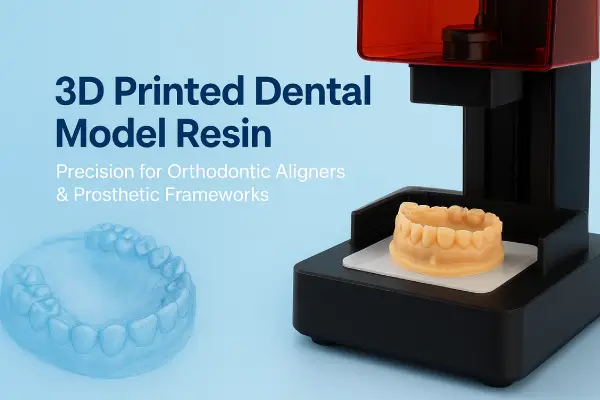
1. Turning Digital Data into Clinical Precision
Every successful orthodontic aligner or prosthetic framework begins with one thing — a precise dental model.
In modern digital dentistry, technologies such as intraoral scanning (IOS) and Cone-Beam CT (CBCT) have replaced messy impressions and manual stone models. But to translate this digital data into real-world precision, 3D-printed dental models serve as the essential bridge between design and fabrication.
Whether it’s thermoforming clear aligners, fitting removable partial dentures (RPDs), or creating surgical guides, the quality of the printed model directly determines the accuracy, comfort, and clinical success of the final appliance.
2. Why Dental Model Resin Matters: Precision Built from Material Science
High Dimensional Accuracy
Professional dental model resins are designed to capture every micron of digital detail from patient scans.
With layer resolutions as fine as 25 μm and low linear shrinkage (<2%), these resins reproduce occlusal anatomy and gingival contours with unmatched fidelity — ensuring perfect appliance fit and minimal post-processing.
Thermal and Mechanical Stability
During aligner production or prosthetic framework fitting, dental models undergo high pressure and heat.
That’s why thermal-resistant model resins (withstanding >100 °C / 212 °F) are essential to maintain model geometry during thermoforming.
Their robust flexural modulus (≥2500 MPa) and Shore D hardness (80–94) ensure mechanical strength, stability, and easy trimming without deformation.
Safety and Biocompatibility
While model resins aren’t intraoral materials, they still play a role in laboratory hygiene and technician safety.
Resins conforming to ISO 10993 biocompatibility standards minimize cross-contamination risks and ensure safe handling throughout the workflow.
3. Specialized Applications: From Orthodontic Labs to Prosthetic Design
Orthodontic Applications
- Clear Aligners & Retainers: The most common use. Each treatment stage is printed as a physical model, over which PET-G sheets are vacuum-formed to produce perfectly fitting aligners.
- Splints & Positioning Devices: Models also serve to fabricate bite splints and positioning templates, supporting precise occlusal adjustments.
Prosthetic and Restorative Applications
- Removable Partial Denture (RPD) Frameworks: Printed master models eliminate the inaccuracies of traditional investment casting, enabling highly consistent digital workflows from scan to cast.
- Implant Surgical Guides: Autoclavable, biocompatible models and guides ensure safe and accurate implant placement.
- Full-Arch and Segment Models: Ideal for crowns, bridges, or complex restorations, providing precision that often exceeds traditional stone models.
4. Technical and Clinical Advantages of the Digital Workflow
- Faster Turnaround Time
From intraoral scan to printed model in just hours — labs can now offer same-day or next-day appliances. - Unmatched Reproducibility
Every model printed from the same digital file is dimensionally identical, eliminating human variability. - Seamless Design Iteration
Need to modify a tooth movement or framework? Simply update the file and reprint — no new impression needed. - Sustainable and Efficient
Additive manufacturing uses less material and produces less waste than traditional casting or milling methods.
For dental labs producing dozens of aligners per day, digital printing transforms efficiency — enabling consistent, repeatable results at scale.
5. The Foundation of Modern Digital Dentistry
3D-printed dental models are no longer just digital substitutes for plaster. They are the foundation of precision-driven dentistry, empowering clinicians and labs to deliver accurate, predictable, and comfortable outcomes for every patient.
As model resin technologies continue to evolve — offering higher heat resistance, smoother surfaces, and sub-25 μm resolution — the potential of digital workflows in orthodontics and prosthetics will only expand.
Discover Precision You Can Rely On
IFUN Dental Model Resin is engineered for high accuracy, stability, and clean post-processing — ideal for orthodontic aligners, splints, and prosthetic frameworks.
Learn more about IFUN Dental 3D Printing Resins


